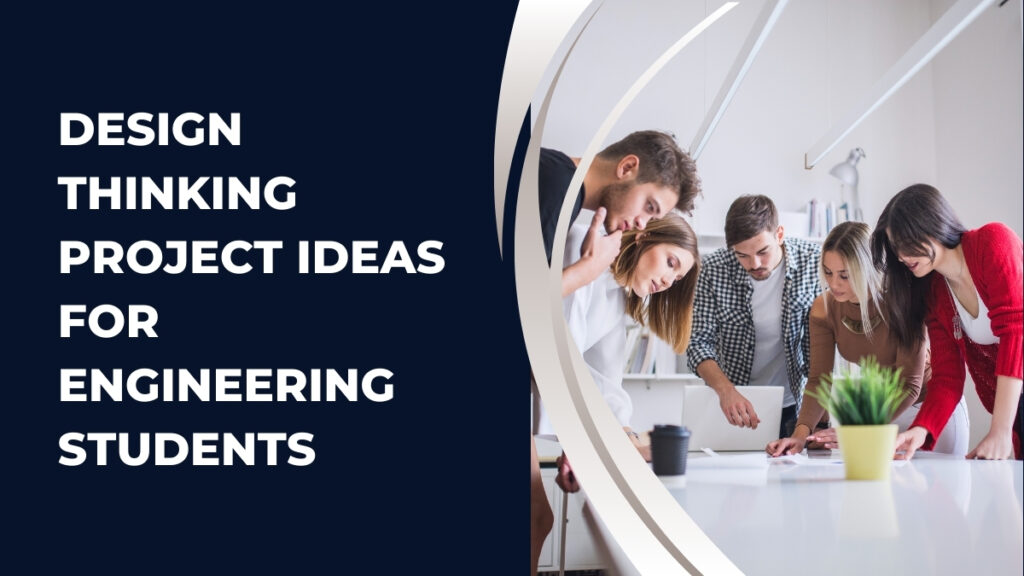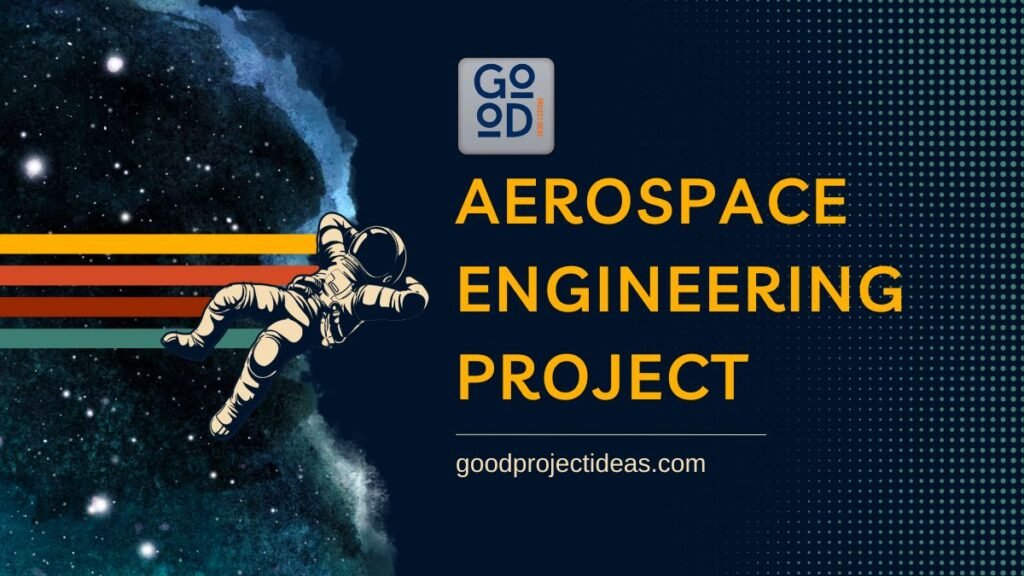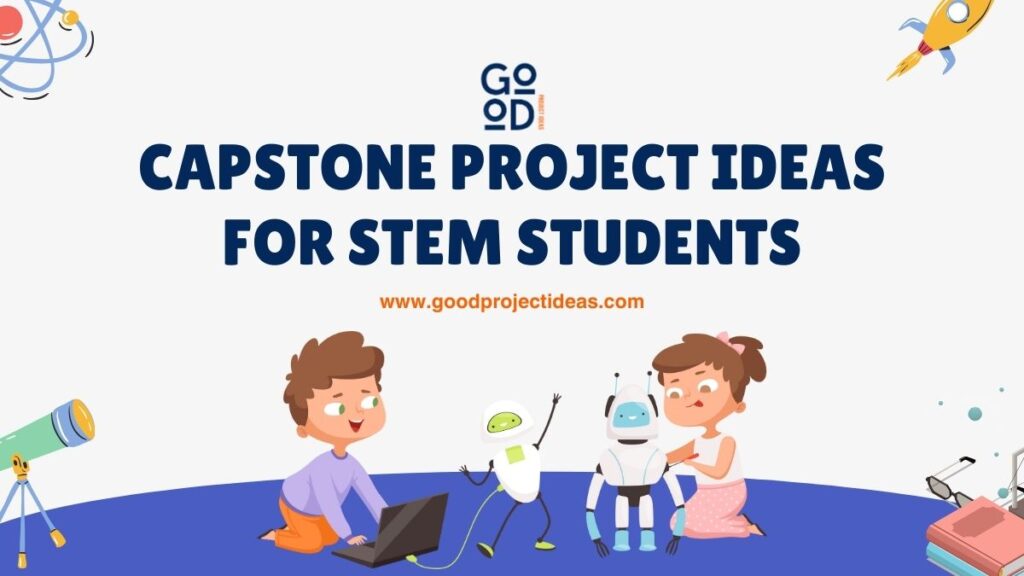Discover fun and creative design thinking project ideas for engineering students. Boost your skills and bring your ideas to life!
Design thinking is a creative way to solve problems with a user-first focus. For engineering students, it’s a great tool for innovation and practical solutions. This guide offers simple project ideas to apply design thinking. Whether for class or fun, these ideas will boost your creativity and problem-solving skills.
What is Design Thinking?
Design thinking is a user-focused approach to problem-solving. It involves empathy, ideation, prototyping, and testing.
Unlike traditional methods, it emphasizes understanding the problem deeply before finding solutions. This approach encourages collaboration, creativity, and experimentation.
By putting the user at the center, design thinking helps engineers create products, services, and systems that truly meet people’s needs.
Design Thinking Project Ideas for Engineering Students PDF
Importance of Design Thinking for Engineers
Design Thinking is a powerful tool that enhances the engineering process. Here’s why:
| Benefit | Description |
|---|---|
| User-Centric Focus | Creates more relevant and usable products. |
| Innovation Catalyst | Sparks creative problem-solving. |
| Reduced Development Time | Minimizes building the wrong product. |
| Improved Collaboration | Boosts teamwork. |
| Enhanced Problem-Solving | Provides a structured approach. |
| Increased Market Success | Leads to more successful products. |
Incorporating design thinking helps engineers create impactful, user-friendly solutions.
How Design Thinking can be applied to Engineering
Design Thinking provides a structured approach to solving engineering challenges. Here’s how to apply it:
Empathize: Understand the User
- Identify the target audience.
- Conduct research to understand needs.
- Gain user insights.
Define the Problem
- Clearly state the problem.
- Translate user needs into problem statements.
- Identify constraints and requirements.
Ideate: Generate Solutions
- Brainstorm a wide range of ideas.
- Use mind mapping to connect ideas.
- Apply SCAMPER to modify existing solutions.
Prototype: Build and Test
- Create quick models or simulations.
- Continuously refine based on feedback.
- Test with users to gather insights.
Test: Validate the Solution
- Observe user interactions with prototypes.
- Analyze feedback.
- Iterate and improve the design.
By following these steps, engineers can create innovative and user-focused solutions.
The Five Stages of Design Thinking
Design Thinking is a human-centered approach to problem-solving that involves five stages:
Empathize
- Research user needs and pain points.
- Observe and engage with users.
- Create user personas.
Define
- Clearly articulate the problem.
- Develop a concise problem statement.
- Translate insights into specific needs.
Ideate
- Brainstorm a range of solutions.
- Challenge existing approaches.
- Visualize ideas with sketches or mind maps.
Prototype
- Create physical or digital prototypes.
- Continuously improve based on feedback.
- Experiment with different designs.
Test
- Gather user feedback on prototypes.
- Make adjustments based on feedback.
- Ensure the solution meets user needs.
By following these stages, designers can create innovative and user-friendly solutions.
Real-world examples of Design Thinking in action
Design Thinking has been successfully applied in various industries. Here are some notable examples:
Technology
- Apple: Designed the user-friendly iPhone.
- Netflix: Personalized recommendations.
- Uber: Created a user-centric transportation app.
Healthcare
- GE Healthcare: Developed easy-to-use medical equipment.
- PillPack: Simplified medication management.
Consumer Goods
- Procter & Gamble: Innovated with the Swiffer.
- LEGO: Designed creative, educational toys.
Social Impact
- IDEO: Developed affordable water filters.
- Design for the Disabled: Created inclusive products and environments.
These examples show how Design Thinking leads to innovative solutions and adds value for users.
Tools And Techniques for Each Stage
Check out tools and techniques for each stage:-
Empathize Stage
- Observation: Watch users in their environment.
- Interviews: Talk to users directly.
- Surveys: Collect quantitative data.
- Empathy Maps: Visualize user emotions.
- Journey Mapping: Outline user experiences.
Define Stage
- Affinity Mapping: Group related ideas.
- Journey Mapping: Visualize user interactions.
- Problem Statement: Clearly define the problem.
- HMW Questions: Generate solution ideas.
Ideate Stage
- Brainstorming: Generate many ideas.
- Mind Mapping: Organize ideas visually.
- SCAMPER: Modify existing solutions.
- Six Thinking Hats: Explore different perspectives.
Prototype Stage
- Sketching: Create quick visual ideas.
- Rapid Prototyping: Build quick, low-fidelity models.
- Digital Prototyping: Use software for interactive prototypes.
Test Stage
- Usability Testing: Observe user interactions.
- A/B Testing: Compare different versions.
- Feedback Analysis: Review user feedback.
- Iterative Design: Refine and retest solutions.
Design Thinking Project Ideas For Engineering
Design Thinking Project Ideas in Different Categories
Product Design
Redesigning everyday objects
- Focus on improving the user experience of common household items.
- Enhance functionality and aesthetic appeal.
Developing assistive technology
- Create devices to aid people with disabilities.
- Ensure usability and accessibility.
Designing sustainable products
- Develop eco-friendly alternatives to existing products.
- Focus on reducing environmental impact.
Smart home devices
- Innovate household gadgets that enhance convenience and connectivity.
- Integrate with existing smart systems.
Wearable technology
- Design wearable devices that integrate with daily activities.
- Ensure comfort and durability.
Ergonomic furniture
- Create furniture that supports healthy posture and comfort.
- Focus on functionality and aesthetic appeal.
Modular furniture
- Develop furniture that can be easily reconfigured to suit different spaces.
- Ensure ease of assembly and versatility.
Eco-friendly packaging
- Design sustainable packaging solutions for consumer products.
- Focus on biodegradability and recyclability.
Child-friendly products
- Create safe and engaging products for children.
- Ensure durability and ease of use.
Portable kitchen appliances
- Innovate compact and multifunctional kitchen gadgets.
- Focus on efficiency and user convenience.
Service Design
Improving healthcare experiences
- Design a better patient journey in hospitals or clinics.
- Enhance communication and comfort.
Enhancing public transportation
- Create a more efficient and user-friendly transportation system.
- Focus on accessibility and convenience.
Designing educational experiences
- Improve the learning experience for students.
- Integrate technology for interactive learning.
Retail experience redesign
- Enhance in-store and online shopping experiences.
- Focus on customer engagement and satisfaction.
Banking services
- Innovate to improve customer interaction with banking services.
- Ensure security and ease of use.
Tourism services
- Develop seamless and enjoyable travel experiences.
- Focus on convenience and personalization.
Public service platforms
- Improve citizen interaction with government services.
- Ensure accessibility and efficiency.
Event management services
- Design more efficient and engaging event planning processes.
- Focus on user experience and logistical efficiency.
Food delivery services
- Optimize delivery processes for speed and freshness.
- Enhance user experience through tracking and communication.
Library services
- Enhance user experience in public libraries.
- Integrate technology for better resource management.
Social Impact
Addressing urban challenges
- Develop solutions for issues like traffic congestion, pollution, or housing.
- Focus on sustainability and community engagement.
Creating accessible public spaces
- Design inclusive environments for people of all abilities.
- Ensure safety and usability.
Developing sustainable communities
- Promote eco-friendly living and resource management.
- Focus on community participation and education.
Educational outreach programs
- Design initiatives to improve access to education.
- Focus on underserved communities and innovative teaching methods.
Health awareness campaigns
- Create programs to raise awareness about health issues.
- Focus on prevention and community involvement.
Community gardens
- Develop spaces for urban agriculture.
- Encourage community participation and sustainable practices.
Affordable housing solutions
- Innovate to provide cost-effective housing.
- Focus on sustainability and livability.
Public health initiatives
- Design campaigns to improve public health.
- Focus on preventive measures and education.
Disaster relief systems
- Develop efficient and effective emergency response systems.
- Ensure quick deployment and resource management.
Youth engagement programs
- Create activities and programs to engage young people in community building.
- Focus on skill development and social responsibility.
Engineering Systems
Optimizing energy grids
- Design more efficient and resilient energy systems.
- Integrate renewable energy sources.
Improving water management
- Develop sustainable water solutions.
- Focus on conservation and efficient distribution.
Designing smart cities
- Create interconnected and sustainable urban environments.
- Implement smart infrastructure and resource management.
Automated manufacturing systems
- Innovate in the automation of manufacturing processes.
- Focus on efficiency and precision.
Transportation networks
- Design integrated and efficient transport systems.
- Ensure connectivity and accessibility.
Building management systems
- Develop smart systems for managing building utilities.
- Focus on energy efficiency and comfort.
Telecommunications networks
- Enhance the efficiency and reach of communication systems.
- Implement advanced technologies for better connectivity.
Waste management systems
- Optimize waste collection and recycling processes.
- Focus on sustainability and efficiency.
Logistics and supply chain
- Improve the efficiency of logistics and supply chain operations.
- Implement real-time tracking and data analysis.
Agricultural systems
- Innovate in sustainable and efficient farming techniques.
- Focus on yield improvement and resource conservation.
Transportation
Designing safer vehicles
- Enhance vehicle safety features.
- Focus on driver assistance and crash prevention.
Improving public transportation
- Create more efficient and accessible transportation systems.
- Ensure reliability and user comfort.
Developing sustainable mobility solutions
- Promote eco-friendly transportation options.
- Focus on reducing carbon footprint and cost.
Electric vehicle infrastructure
- Develop systems to support electric vehicles.
- Ensure widespread availability and quick charging.
Autonomous vehicles
- Innovate in self-driving technology.
- Focus on safety and reliability.
Bicycle-sharing systems
- Design efficient bike-sharing networks.
- Ensure accessibility and convenience.
Urban transit planning
- Optimize city transit routes and schedules.
- Focus on reducing congestion and travel time.
Intermodal transport hubs
- Create efficient transfer points for different transport modes.
- Focus on seamless connectivity and user convenience.
High-speed rail systems
- Develop faster and more efficient train systems.
- Focus on reducing travel time and increasing capacity.
Aviation advancements
- Innovate in aircraft design for better efficiency and safety.
- Implement advanced navigation and control systems.
Infrastructure and Environment
Smart city solutions
- Develop sustainable urban infrastructure.
- Implement smart sensors and IoT devices.
Disaster management systems
- Design resilient systems for emergency response.
- Implement early warning systems for natural disasters.
Renewable energy solutions
- Create innovative energy generation and distribution systems.
- Focus on integrating renewable energy sources.
Water management systems
- Improve water access and quality.
- Implement advanced treatment technologies.
Green building designs
- Develop eco-friendly construction techniques.
- Focus on energy efficiency and sustainability.
Urban green spaces
- Design and implement parks and green areas in cities.
- Focus on accessibility and usability for all residents.
Stormwater management
- Create efficient systems to handle urban runoff.
- Implement green infrastructure like rain gardens and permeable pavements.
Wastewater treatment
- Innovate in the treatment and reuse of wastewater.
- Implement advanced technologies for efficiency and sustainability.
Noise pollution reduction
- Develop solutions to minimize urban noise.
- Implement sound barriers and noise-absorbing materials.
Air quality monitoring
- Design systems to monitor and improve air quality.
- Implement advanced sensors and data analytics.
Business and Industry
Supply chain optimization
- Improve efficiency and sustainability in supply chains.
- Implement real-time tracking and monitoring systems.
Customer experience design
- Enhance customer interactions and satisfaction.
- Implement omnichannel strategies for seamless experiences.
Process improvement
- Redesign internal processes for better efficiency.
- Implement lean principles to reduce waste.
New business models
- Develop innovative business concepts.
- Focus on scalability and sustainability.
E-commerce platforms
- Innovate in online shopping experiences.
- Implement secure and efficient payment systems.
Financial technology (FinTech)
- Develop solutions for modern banking and finance.
- Implement secure and efficient transaction systems.
Marketing automation
- Design systems to optimize marketing efforts.
- Implement tools for campaign management and analysis.
Human resources management
- Innovate in HR processes and employee engagement.
- Implement tools for recruitment and performance management.
Product lifecycle management
- Improve the management of product development cycles.
- Implement tools for collaboration and communication.
Sustainable business practices
- Develop and implement eco-friendly business strategies.
- Focus on reducing environmental impact.
Process Improvement
Optimizing manufacturing processes
- Identify bottlenecks and improve efficiency.
- Implement automation and advanced technologies.
Designing a more efficient supply chain
- Reduce costs and environmental impact.
- Implement real-time tracking and monitoring systems.
Improving customer service experiences
- Enhance customer satisfaction through process redesign.
- Implement tools for real-time feedback and support.
Inventory management systems
- Optimize stock levels and reduce waste.
- Implement tools for real-time tracking and monitoring.
Lean manufacturing
- Implement lean principles to improve productivity.
- Focus on reducing waste and increasing efficiency.
Quality control systems
- Develop systems to ensure product quality.
- Implement tools for real-time monitoring and analysis.
Workflow automation
- Automate repetitive tasks to increase efficiency.
- Implement tools for collaboration and communication.
Project management tools
- Innovate in tools to manage projects more effectively.
- Implement features for collaboration and communication.
Document management systems
- Improve the handling and retrieval of documents.
- Implement tools for real-time tracking and monitoring.
Employee training programs
- Design efficient and engaging training processes.
- Implement tools for real-time feedback and support.
Healthcare
Designing medical devices
- Create user-friendly and effective medical equipment.
- Implement features for safety and reliability.
Improving patient experience
- Enhance the hospital or clinic environment.
- Implement tools for real-time feedback and support.
Developing healthcare delivery models
- Design efficient and accessible healthcare services.
- Implement features for affordability and sustainability.
Telemedicine solutions
- Innovate in remote healthcare delivery.
- Implement tools for real-time monitoring and support.
Electronic health records
- Improve the efficiency and security of health data.
- Implement tools for real-time tracking and monitoring.
Health monitoring systems
- Develop devices for continuous health tracking.
- Implement features for accuracy and reliability.
Hospital management systems
- Optimize the operations of healthcare facilities.
- Implement tools for real-time tracking and monitoring.
Pharmaceutical logistics
- Improve the distribution of medications.
- Implement tools for real-time tracking and monitoring.
Preventative health programs
- Design initiatives to prevent diseases.
- Implement features for education and community engagement.
Mental health services
- Innovate in the delivery of mental health care.
- Implement tools for real-time feedback and support.
Energy and Environment
Renewable energy solutions
- Develop innovative ways to harness renewable energy sources.
- Implement tools for real-time tracking and monitoring.
Waste management systems
- Design efficient and sustainable waste management solutions.
- Implement features for recycling and resource recovery.
Smart cities
- Create sustainable and livable urban environments.
- Implement tools for real-time tracking and monitoring.
Energy-efficient buildings
- Develop techniques for reducing building energy consumption.
- Implement features for insulation and energy management.
Water conservation
- Innovate in methods to save and reuse water.
- Implement tools for real-time tracking and monitoring.
Carbon footprint reduction
- Create strategies to minimize carbon emissions.
- Implement features for monitoring and analysis.
Sustainable agriculture
- Develop eco-friendly farming practices.
- Implement tools for real-time tracking and monitoring.
Climate change mitigation
- Design systems to reduce the impact of climate change.
- Implement tools for real-time tracking and monitoring.
Pollution control
- Innovate in technologies to reduce air and water pollution.
- Implement features for monitoring and analysis.
Renewable energy storage
- Implement tools for real-time tracking and monitoring.
- Develop efficient storage solutions for renewable energy.
Most Popular Design Thinking Project Ideas for Engineering
Check out design thinking project ideas for engineering:-
Mechanical Engineering
Energy-efficient Vehicle
- Idea: Design a fuel-efficient or alternative energy vehicle.
- Skills: Automotive, energy systems
- Duration: 6-9 months
Robotic Arm
- Idea: Create a robotic arm for automation.
- Skills: Robotics, control systems
- Duration: 3-4 months
Bicycle Design
- Idea: Improve bicycle comfort and safety.
- Skills: Mechanical design, ergonomics
- Duration: 2-3 months
Electrical and Electronics Engineering
Renewable Energy System
- Idea: Develop a solar or wind energy system.
- Skills: Renewable energy, circuit design
- Duration: 4-6 months
Smart Grid Tech
- Idea: Design a smart power distribution system.
- Skills: Power systems, IoT
- Duration: 4-6 months
Home Security System
- Idea: Create an advanced security system with sensors and cameras.
- Skills: Electronics, programming
- Duration: 3-4 months
Civil Engineering
Sustainable Building Materials
- Idea: Investigate eco-friendly building materials.
- Skills: Material science, civil engineering
- Duration: 3-4 months
Smart City Infrastructure
- Idea: Develop intelligent traffic management systems.
- Skills: Civil engineering, IoT
- Duration: 4-6 months
Water Management System
- Idea: Design efficient water management solutions.
- Skills: Environmental engineering
- Duration: 3-4 months
Software Engineering
AI Healthcare Solution
- Idea: Develop an AI app for diagnostics.
- Skills: AI, software development
- Duration: 4-6 months
Educational Platform
- Idea: Create a platform for online learning.
- Skills: Web development, UX/UI design
- Duration: 3-4 months
Blockchain Application
- Idea: Design a secure blockchain app for transactions.
- Skills: Blockchain, cryptography
- Duration: 4-6 months
Environmental Engineering
Pollution Monitoring
- Idea: Create a system to monitor pollution levels.
- Skills: Sensor tech, data analysis
- Duration: 3-4 months
Waste Management
- Idea: Design innovative waste recycling solutions.
- Skills: Mechanical design
- Duration: 3-4 months
Green Roof System
- Idea: Develop green roofs to reduce urban heat.
- Skills: Environmental engineering
- Duration: 2-3 months
Biomedical Engineering
Prosthetic Device
- Idea: Design a low-cost prosthetic limb.
- Skills: Biomedical engineering
- Duration: 4-6 months
Medical Imaging Solution
- Idea: Develop improved medical imaging technology.
- Skills: Imaging tech, software development
- Duration: 4-6 months
Wearable Health Monitor
- Idea: Create a wearable health monitoring device.
- Skills: Electronics, software development
- Duration: 3-4 months
Aerospace Engineering
- Agriculture Drones
- Idea: Design drones for crop monitoring.
- Skills: Aerospace engineering, data analysis
- Duration: 3-4 months
- Satellite Communication
- Idea: Develop communication systems for satellites.
- Skills: Electronics, communication systems
- Duration: 4-6 months
- Aerodynamic Vehicle
- Idea: Design a vehicle for better fuel efficiency.
- Skills: Fluid dynamics, mechanical design
- Duration: 4-6 months
Implementing Design Thinking in Engineering Curriculum
Incorporating Design Thinking into the engineering curriculum can be transformative. Here are key strategies:
Curriculum Integration
- Early Introduction: Teach Design Thinking in initial courses.
- Capstone Projects: Include it in final projects.
- Elective Courses: Offer specialized courses or minors.
- Interdisciplinary Collaboration: Work with design, business, and humanities.
Faculty Development
- Workshops: Train faculty in Design Thinking methods.
- Mentorship: Connect faculty with industry experts.
- Curriculum Review: Update courses with Design Thinking principles.
Student Engagement
- Design Challenges: Host competitions and hackathons.
- Student Clubs: Form Design Thinking groups.
- Industry Projects: Provide real-world project opportunities.
Assessment and Evaluation
- Rubrics: Create criteria for Design Thinking projects.
- Portfolios: Encourage documenting the Design Thinking process.
- Feedback: Give regular progress reviews.
These strategies help foster innovation and problem-solving in engineering education.
Challenges and Opportunities in Design Thinking
Design Thinking is powerful but comes with challenges and opportunities:
Challenges
- Resistance to Change: Shifting from traditional methods.
- Time Constraints: Finding enough time for each stage.
- Resource Limitations: Access to tools and data.
- Measuring Impact: Difficult to quantify results.
- Team Dynamics: Ensuring effective collaboration.
Opportunities
- Innovation Culture: Encouraging experimentation.
- Customer-Centricity: Better understanding customer needs.
- Employee Engagement: Empowering problem-solving.
- Competitive Advantage: Gaining a market edge.
- New Business Models: Creating new products or services.
Addressing these challenges and leveraging opportunities maximizes Design Thinking’s benefits.
Tools and Resources for Design Thinking
Design Thinking is enhanced through various tools and resources. Here are some key options:
Digital Tools
- Mind Mapping: MindMeister, Coggle
- Prototyping: Figma, Sketch
- Collaboration: Miro, Trello
- Project Management: Asana, Jira
Analog Tools
- Post-it Notes: For brainstorming
- Whiteboards: For collaborative ideation
- Sketchbooks: For capturing ideas
- Prototyping Materials: Cardboard, clay, etc.
Design Thinking Frameworks
- Empathy Map: Visualizing user needs
- Customer Journey Map: Understanding user experience
- Value Proposition Canvas: Defining customer value
- Business Model Canvas: Outlining business structure
Online Resources
- IDEO U: Online courses
- Stanford d.school: Case studies
- Blogs and Articles: Online inspirations
Combining these tools and resources helps implement Design Thinking effectively in your projects.
Tips for Effective Design Thinking Projects
To maximize the potential of Design Thinking projects, consider these tips:
Cultivating a Design Thinking Mindset
- Embrace Failure: Learn from mistakes.
- Foster Curiosity: Always ask questions.
- Encourage Collaboration: Work as a team.
- Build Empathy: Understand user needs.
Practical Implementation Tips
- Start Small: Begin with a simple project.
- Visualize: Use whiteboards or digital tools.
- Iterate Quickly: Keep improving.
- Celebrate Wins: Reward achievements.
- Involve Stakeholders: Get input from others.
Overcoming Challenges
- Manage Time: Allocate enough time for each stage.
- Supportive Environment: Encourage innovation.
- Measure Impact: Set clear goals.
- Learn from Others: Study successful cases.
These tips will help you enhance your Design Thinking projects and achieve better outcomes.
How is design thinking used in engineering?
Design thinking helps engineers create innovative, user-friendly solutions. Here’s how:
Product Development
- User Needs: Use empathy maps and interviews.
- Ideation: Brainstorm and prototype.
- Testing: Refine based on feedback.
Problem Solving
- Reframe Challenges: View from new perspectives.
- Generate Solutions: Explore diverse approaches.
- Prototype and Test: Build and refine quickly.
Process Improvement
- Analyze Workflows: Identify inefficiencies.
- Design New Processes: Create optimized workflows.
- Measure Impact: Evaluate effectiveness.
Innovation
- Encourage Creativity: Foster experimentation.
- Develop Products: Identify opportunities.
- Improve Usability: Focus on user experience.
Integrating Design Thinking leads to technically sound and user-focused solutions.
How to make a design thinking project?
Design Thinking is a human-centered problem-solving approach with five stages: Empathize, Define, Ideate, Prototype, and Test. Here’s how to apply it:
Identify a Problem
- Choose a problem: Pick a relevant issue.
- Define the scope: Set project boundaries.
Conduct User Research
- Empathize: Understand user needs.
- Gather data: Use interviews, surveys, and observations.
Define the Problem
- Problem statement: Clearly state the problem.
- Identify needs: Define user needs to address.
Generate Ideas
- Brainstorm: Create a wide range of ideas.
- Mind mapping: Connect and visualize ideas.
- SCAMPER: Modify existing solutions.
Create Prototypes
- Build prototypes: Develop models of your solution.
- Test and iterate: Gather feedback and improve.
Test and Refine
- User testing: Observe user interactions.
- Gather feedback: Collect user experience data.
- Iterate: Make changes based on feedback.
Additional Tips
- Diverse team: Use different perspectives.
- Document process: Keep records.
- Continuous iteration: Be ready to make changes.
- Embrace failure: Learn from mistakes.
Follow these steps to create user-centered solutions with Design Thinking.
Conclusion
Design Thinking helps engineering students become innovative problem solvers. By focusing on people, engineers can create products that are both useful and enjoyable.
Whether reimagining everyday items or tackling big challenges, Design Thinking offers a flexible way to solve problems. By teaching these principles, engineering schools prepare students to shape the future.
Remember, Design Thinking is a journey. Embrace trying new things, improving on ideas, and working with others to reach your full potential as an engineer.
Meet Tom Latham from Good Project Ideas! He’s passionate about sparking creativity and making learning fun for all. Tom loves crafting engaging projects that inspire curiosity and hands-on exploration. Join him in bringing ideas to life!



